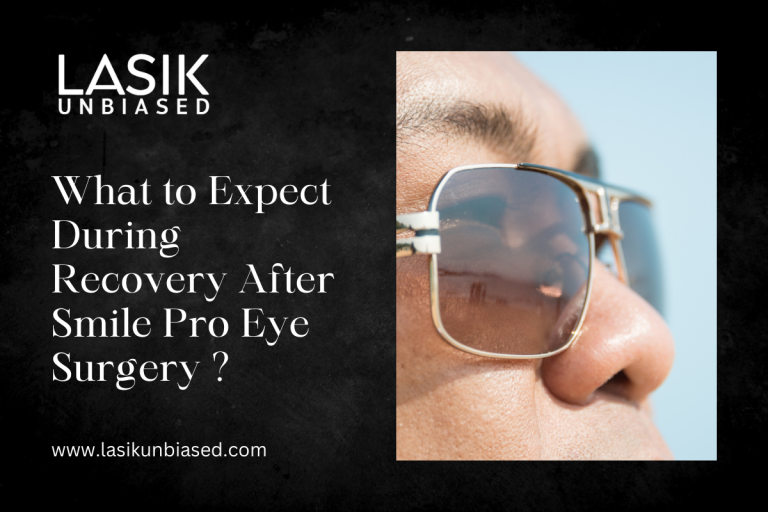SMILE Pro (Small Incision Lenticule Extraction Pro) eye surgery is an advanced and minimally invasive procedure to correct refractive vision problems such as nearsightedness (myopia) and astigmatism. Unlike traditional LASIK, SMILE Pro uses femtosecond laser technology to remove a small lenticule of corneal tissue through a tiny incision, reshaping the cornea and improving visual clarity. Although the procedure is quick and precise, recovery requires careful attention to ensure the best possible results. This article will discuss what to expect during recovery after SMILE Pro eye surgery and provide guidance on optimizing your healing process.
Immediate Post-Surgery Experience
Immediately following SMILE Pro surgery, you will be taken to a recovery area to rest while the effects of the anaesthesia wear off. The procedure is typically performed under local anaesthesia, meaning you will be awake throughout the surgery but won’t feel any pain. You may experience some mild discomfort, dryness, or a sensation of pressure in your eyes right after the surgery. Still, these symptoms are usually temporary and should subside within a few hours.
Your surgeon will monitor you for a short period to ensure there are no complications. In most cases, patients can go home on the same day as the surgery, but you will need someone to drive you home, as your vision may be blurry right after the procedure. Some individuals may experience mild light sensitivity or a slight fogginess in their vision, but this is generally normal and should improve within a few hours.
The First Few Days of Recovery
The first 24 to 48 hours after SMILE Pro surgery are critical for your recovery. To ensure proper healing, it is essential to follow your surgeon’s post-operative instructions carefully during this period. Your doctor will likely prescribe anti-inflammatory and antibiotic eye drops to prevent infection and reduce inflammation. You may also be advised to wear protective goggles while sleeping to prevent accidental rubbing of your eyes.
In the first few days, it’s common to experience blurry vision, light sensitivity, and mild discomfort. It’s also expected to experience some dryness or gritty feelings in the eyes. This is because your cornea adjusts to the new shape, and tear production may be temporarily disrupted. As your surgeon recommends, lubricating eye drops can help alleviate dryness and discomfort.
During this time, you should avoid activities that could strain your eyes, such as reading, using a computer, or watching TV for long periods. It’s also essential to refrain from rubbing your eyes, as this can interfere with the healing process and increase the risk of complications.
The First Week of Recovery
By the end of the first week, you should notice a significant improvement in your vision. While your eyesight may not be perfectly clear immediately, most patients experience an improvement within a few days to a week. The slight blurriness and light sensitivity should diminish, and your eyes will feel more comfortable.
During this week, you may still experience mild dryness or a sensation of a foreign object in your eye, but these symptoms should gradually subside as your cornea heals. Continue using the prescribed eye drops, and attend follow-up appointments with your surgeon. These appointments are essential for ensuring your eyes are healing as expected and addressing any concerns you may have during recovery.
Although your vision may improve significantly during the first week, it is essential to avoid certain activities that could hinder your recovery, such as swimming, using hot tubs, or engaging in vigorous physical activities that may strain your eyes.
The First Month After SMILE Pro Surgery
In the first month after your SMILE Pro procedure, your vision should continue to improve, and you will notice a significant reduction in the blurry or hazy vision that may have been present in the early stages of recovery. By this point, many patients experience clear vision, although some may still experience mild fluctuations in vision. These fluctuations are expected as the eyes heal and adjust to the new corneal shape.
It is important to avoid rubbing your eyes, as doing so could disrupt the healing of corneal tissue and increase the risk of complications. You should also avoid exposing your eyes to dust, smoke, or chemicals during this period to protect your sensitive eyes from irritation or infection.
While most people can return to normal activities within a few days to a week, avoiding strenuous exercise or activities that could put pressure on the eyes is essential. Your surgeon will provide specific guidelines regarding the timeline for resuming physical activities.
Long-Term Recovery and Vision Stabilization
Most of your recovery will occur in the first few weeks after SMILE Pro surgery, but complete stabilization of your vision can take up to three to six months. During this period, your cornea will continue to heal and reshape, and you may notice occasional fluctuations in your vision as the eye adjusts. These fluctuations are temporary and should gradually diminish as your eyes reach their final shape.
While most patients achieve excellent vision within the first month, it may take a few months for your eyes to stabilize fully. You should continue attending follow-up appointments with your surgeon to monitor the healing progress and address any concerns. Once your eyes have fully healed, most patients are able to enjoy clear, stable vision without the need for glasses or contact lenses.
What to Avoid During Recovery
To ensure the best possible outcome after SMILE Pro surgery, there are several activities you should avoid during the recovery period. These include:
1. Rubbing Your Eyes – Rubbing can irritate, disrupt healing, or even cause the corneal tissue to shift.
2. Swimming or Hot Tubs – Exposure to chlorine or bacteria in water can increase the risk of eye infections during the healing process.
3. Strenuous Exercise – High-impact activities, especially those that increase the risk of injury, should be avoided for several weeks.
4. Exposure to Dust or Chemicals – Protect your eyes from airborne particles, smoke, or chemicals that could cause irritation or infection.
5. Driving Immediately After Surgery – You should avoid driving for the first 24 to 48 hours after surgery due to temporary blurry vision.


